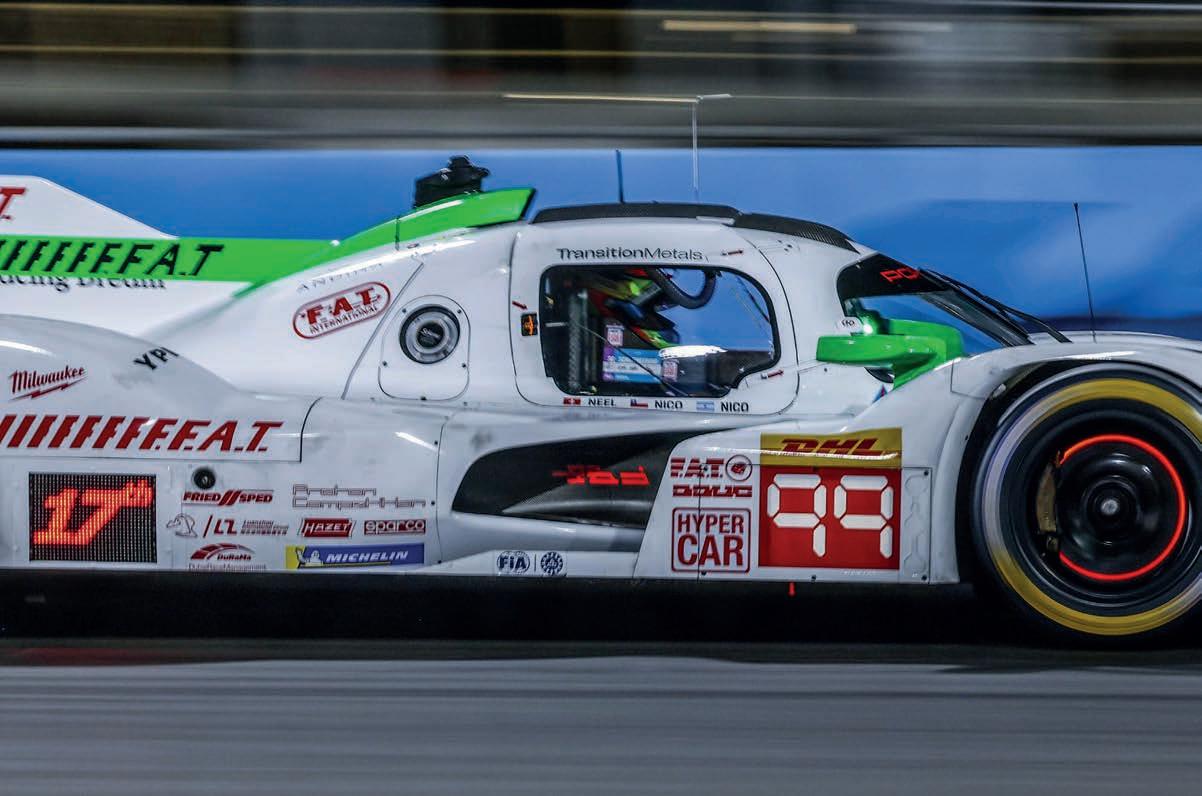








The Prancing Horse won at Le Mans once again, but there was more to the race than meets the eye
By ANDREW COTTON
For a while there it looked as though Ferrari would dominate the final standings with a 1-2-3 result, but the 24 Hours of Le Mans rarely works like that. The 499Ps worked their way into the top positions within the first four hours of the race after qualifying poorly, using their exemplary long run form to good effect in the opening portion.
They remained at the sharp end for much of the race, too; only one Porsche 963 was able to keep up with them. The other contenders, meanwhile, fell by the wayside, hampered by a lack of performance in at least one area, or three in Alpine’s case, including downforce, traction and straight-line speed. Ferrari wasn’t top of the pile in any of these areas, but was excellent on a full stint length.
After sterling work by the AF Corse team in the practice sessions to cure a set up issue that left the cars struggling on tyre wear during a triple stint, tyre supplier Michelin was stunned to see every one of the 499Ps run three stints from the start. Michelin engineers cleared them to go for a third stint from the second pit stop of the race.
Ultimately, the race result was decided in favour of the privateer AF Corse team and its drivers, Robert Kubica, Yifei Ye and Phil Hanson. Kubica became Poland’s first overall Le Mans winner, and Ye the first for China. It was also vindication for both drivers who lost the LMP2 lead on the final lap in 2021. Porsche finished second courtesy of Laurens Vanthoor, Kévin Estre, who put in an incredible first stint to pull the car into contention, and Matt Campbell.
The factory Ferrari AF Corse team finished third, with 2023 winners, James Calado, Alessandro Pier Guidi and Antonio Giovinazzi, guiding their wounded car over the line, nursing an engine issue that threatened to knock them out of the race altogether. Behind them finished the sister no.50 Ferrari, featuring last year’s winning crew.
However, that car was disqualified on Monday evening, when it was found to have four bolts missing in its rear wing support, which allowed the rear wing to flex by 52mm, far beyond the mandated 15mm limit. Despite claims from the team that the omission offered no straight-line advantage,
the stewards highlighted that the no.50 car hit its highest top speed on lap 380 of 387, after the team had noticed a crucial bolt was missing. Ferrari responded by saying that the no.50 car achieved that speed while in the slipstream of the ailing no.51.
From the start of the weekend, it was clear Ferrari had the upper hand in terms of race performance. Stories flooded the paddock of the immense straight-line speed of the 499P, but there was no way we were ever going to see that proven ahead of the weekend. The Balance of Performance for the race was locked in early. It looked at two areas: firstly, the FIA homologation parameters of weight, power and aerodynamic efficiency, all of which were fixed and unwavering. Secondly, top speed, adjustments to which could be made if anything amiss was spotted.
‘We wanted to remove any incentive from WEC performance results going into Le Mans and avoid sandbagging,’ said the ACO’s competition director, Thierry Bouvet.
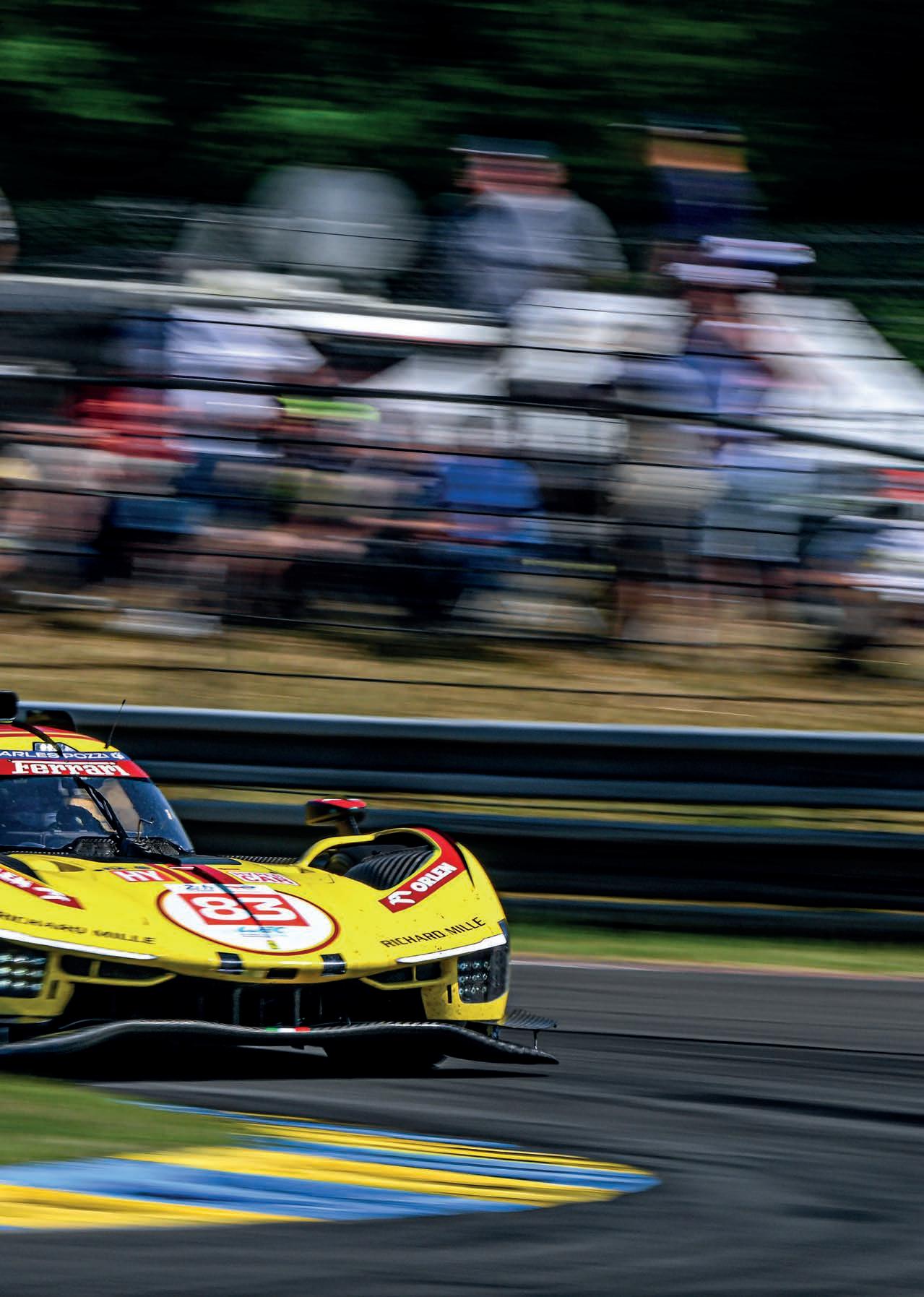
‘We wanted to remove any incentive from WEC performance results going into Le Mans and avoid sandbagging’
Thierry Bouvet, competition director at the
ACO
How Damien Bradley transformed a £500 shopping car into the current fastest closed car on the UK hillclimb scene
By MIKE BRESLIN
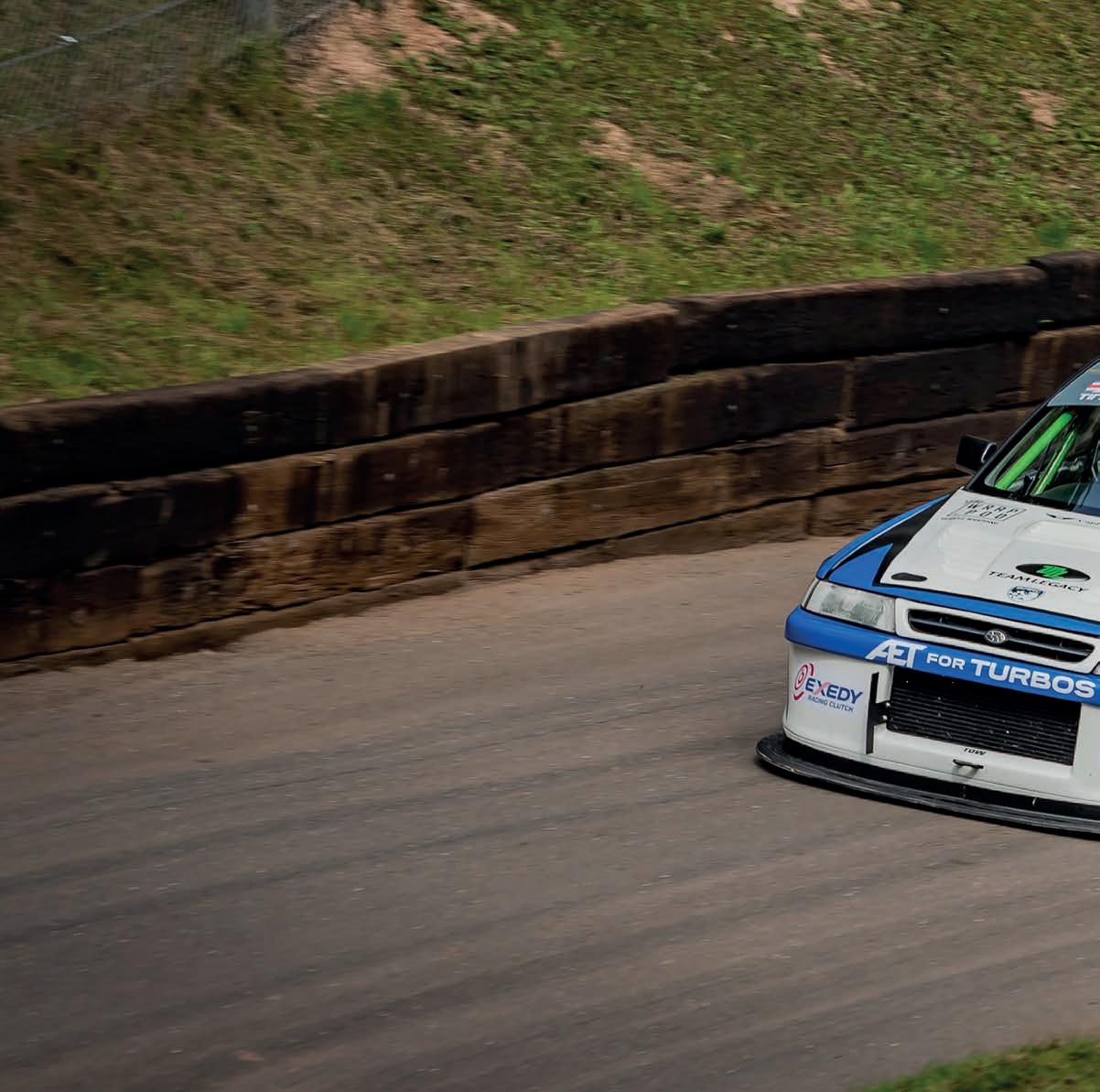
While 800bhp in a club or national level racecar is impressive, it’s not quite as unusual as it once was. There are a handful of cars with this level of horsepower in Time Attack, for example, as well as drag racing of course. What is more unusual is to have an 800bhp car that still looks like a regular road car, yet that’s the trick Damien Bradley has pulled off with his remarkable Subaru Legacy hillclimb machine. Bradley’s Legacy is, arguably, the quickest car with a roof on it that currently competes on the ferociously competitive British
hillclimb scene, even making the Top 12 Runoff against the unlimited, big-downforce single seaters when the tracks are on the damp side. By the time you read this, it will also have competed at the Pikes Peak International Hill Climb. Quite an achievement for something that started life as an old lady’s shopping car. Croydon, UK-based Bradley had always wanted a Legacy, rather than the more obvious Subaru offering, the Impreza, and there were a few good reasons for this: ‘One of the biggest things was the affordability, and the fact the Legacy was never a car that
would be considered boy racer-ish,’ he says. ‘It was under the radar, yet the platform allowed for every GC8 [first generation Impreza] modification; everything is interchangeable.’
The car Bradley currently campaigns on the hills is actually his second Legacy, bought after making the decision to find a lighter, two-wheel drive base model, without a sunroof. He tracked this 1992 example down in south east London and purchased it for just £500. ‘It genuinely was a little old lady’s car that she used for shopping,’ he says with a grin.
‘It was under the radar, yet the platform allowed for every GC8 [first generation Impreza] modification; everything is interchangeable’
Damien Bradley, owner / driver
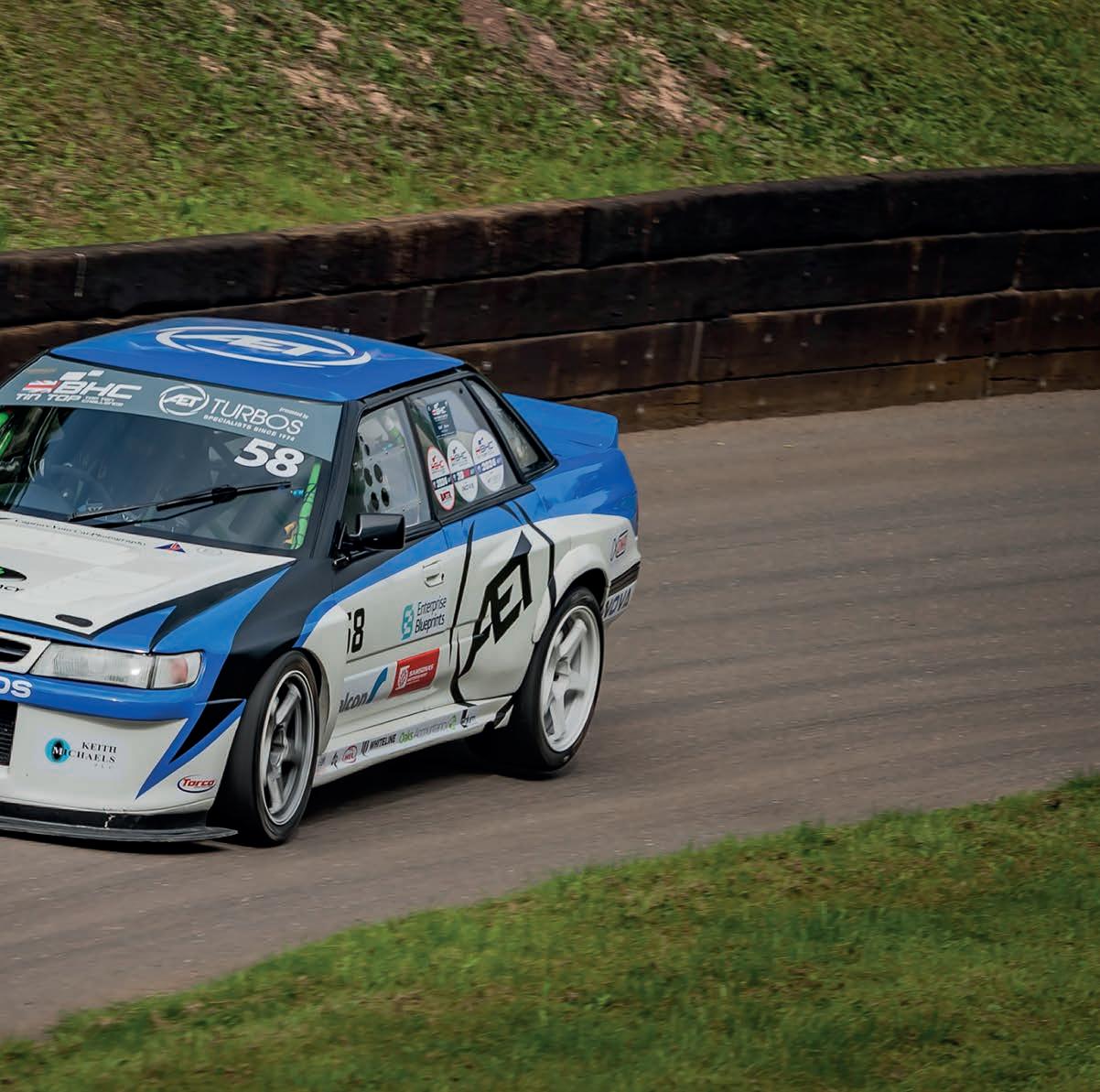
However, he estimates that around £150,000’s worth of work has gone into the car over the past 14 years or so, but stresses this has not been a money-no-object affair. He works as a builder, and it’s been a gradual process to get the now four-wheel drive machine to a point where it’s been able to beat the closed car record at Shelsley Walsh.
The competitive development of the Legacy started in Time Attack, the no-holdsbarred, against-the-clock, circuit-based category but, as his interest in the discipline waned, Bradley discovered hillclimbing, largely through the involvement of his friend,
Steven Darley. Darley runs an Impreza on the hills and has had a big input into the development of the Legacy. After a few runs up the Shelsley course, Bradley was hooked.
While both Time Attack and hillclimbing are against the clock, the scenes are quite different, as are the cars that compete. Largely because Bradley had resisted the temptation to develop a full aero package for his car –whereas some of the Time Attack aero is very dramatic indeed – he did not have to radically alter the Legacy to fit the hillclimb regulations, which in the saloon car classes do not allow for much in the way of aero development.
‘I hadn’t fully investigated aerodynamics because the car worked well as it was,’ says Bradley of the Legacy when it was in Time Attack spec. ‘I was also on a tight budget, so I didn’t have crazy aero, just a rear wing, and only a basic one I bought on eBay. I also had some removable front canards on it that were made by ABW Motorsport, who also made the wide ’arch body kit.’
The body kit was added after Bradley found the 400bhp his engine was producing at the time was too much for the semi-slicks, and then rally slicks, he was using; the car clearly needed a bigger tyre footprint.
Encouraged by Chevrolet general manager, Ed Cole, John Dolza and Zora Arkus-Duntov led development of a new concept for Corvette in 1957 that went on to make history
By KARL LUDVIGSEN

‘Is fuel injection possible by Sebring?’
That was the hopeful enquiry from racing driver, John Fitch, to Ed Cole, Rosey Rosenberger and Zora ArkusDuntov on 29 February 29 1956 when the 12 Hours of Sebring race was only four weeks away. Fitch, who had enjoyed the benefits of injection at Mercedes-Benz, was eager to have it for Corvette’s first big race. Cole, too, was impatient to enjoy injection’s advantages, but for Sebring in ’56 was overly optimistic.
As the General Motors division’s chief engineer, Edward Nicholas Cole was deeply involved in planning for the new 1957 model,
fielding press previews, dealer meetings and final conferences on advertising strategy. This would be the first new Chevy that would be all Cole’s own, the car that would kick off his recent appointment as vice president of General Motors and, more importantly, general manager of its Chevrolet division. Cole felt the 1957 Chevrolet needed something extra. The stylists had delivered a fine facelift, but its basic body still dated from 1955, while rivals Ford and Plymouth were busy stacking up all-new designs. A new engine option was to be offered, using the 3-7/8in bore of the 1956 Sebring-modified
Corvette to bring the V8’s displacement to 283ci, but this alone was not likely to make engineering history.
For his 1957 Chevys, and especially for the sporty Corvette, Cole wanted fuel injection. The auto industry had been talking about it, and experimenting with it, for years and GM had developed its own system, though in the summer of 1956 it was not yet cleared for production. That’s what Cole wanted.
Since the early 1950s, GM’s central engineering staff had been working on various devices capable of delivering carefully metered amounts of fuel directly to each
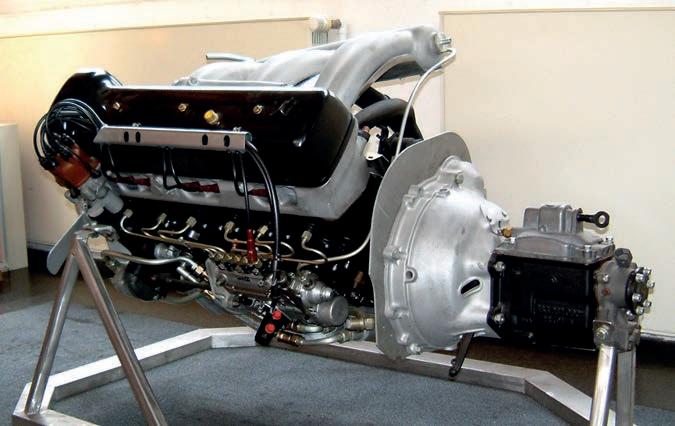
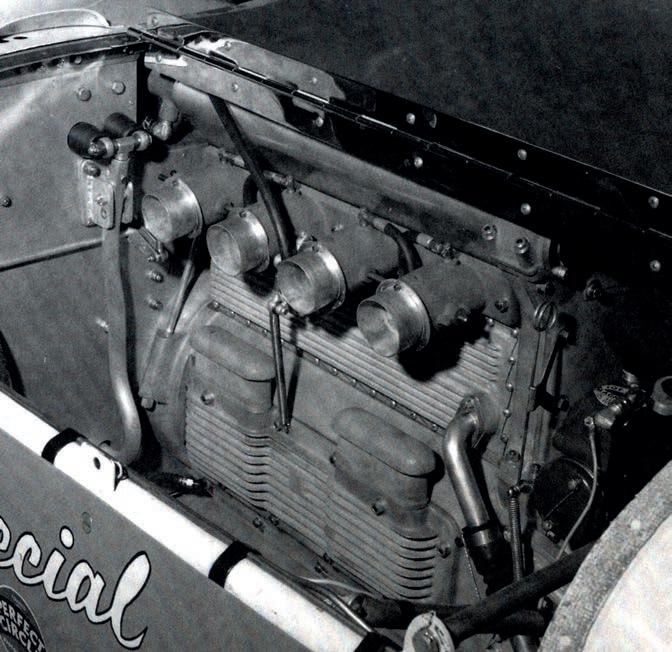
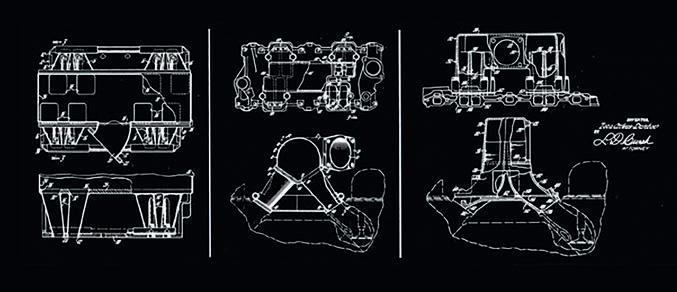
‘A fuel system capable of correcting even 50 per cent of the average carburettor deficiencies may produce a 10 per cent improvement in fuel economy that would ultimately result in substantial savings to the customer’
Giovanni ‘John’ Dolza
cylinder in exact proportion to the incoming air under all operating conditions. The reason being carburettors, and their associated long manifolds, had long been considered unsatisfactory and inefficient.
At GM, research on injection was headed by Giovanni ‘John’ Dolza. Born in Turin, Italy in 1902, Dolza earned an engineering doctorate from that city’s Technical Institute before arriving in America in the early 1920s. Dolza found his way to Detroit and, in 1927, to GM’s Buick division, where his special talents were recognised. The first of Dolza’s many patents were filed in January 1929, for a combined air cleaner and silencer, followed four months later by a new design of carburettor.
When Buick’s chief engineer, Charles Chayne, took over the corporation’s engineering department, he immediately put Dolza in charge of power development. A master of sophisticated control systems, Dolza was the ideal man to take up the fuel injection challenge.
Enlightening the Society of Automobile Engineers (SAE) about GM’s system in 1957, Dolza cited some of its potential advantages over carburetion: ‘A fuel system capable of correcting even 50 per cent of the average carburettor deficiencies may produce a 10 per cent improvement in fuel economy that would ultimately result in substantial savings to the customer. The possibility of an exhaust free from hydrocarbons and a fuel system free from evaporation would greatly help in an important phase of reducing air pollution.’ These were appealing attributes long before emission control became an issue in America.
Reaching an advanced experimental stage in the 1930s, fuel injection made fast progress during the Second World War for use in aero engines. Germany’s Bosch pioneered the use of timed injection in two-stroke engines

A deep dive into the advanced telemetric data sharing system used in NASCAR
By BOZI TATAREVIC
NASCAR is unique in many ways, not least the fact that it gives all competitors access to a limited set of telemetric data.
This feature debuted as part of the NASCAR Team Analytics application that was introduced in in 2019, which featured data collected by SportsMedia Technology (SMT) that teams could subscribe to. This was introduced in response to various teams
using external audio and video analysis to try and reverse engineer telemetry information from their competitors. Separately, NASCAR collected timing, scoring and pit stop information, which was available to competitors via various data streams, and a few years ago the organising body decided to improve all of these elements and combine them under a new platform.

NASCAR started development of the Event Racing Data Platform (ERDP) in 2023 and put it into production the following year. The core functionality of the ERDP is to act as a publishing engine for telemetry and optical tracking data. ERDP initially collected data from SMT’s tracking system, alongside a new optical tracking system from Bolt6, along with telemetry from the McLaren Applied ECU and associated sensors in the car. The Bolt6 optical tracking system eventually replaced the functionality of SMT’s system, although data is still being displayed through the SMT data viewer, albeit supplied by data from ERDP.
To find out the latest developments, Racecar spoke with Dane Vander Haar, managing director of electronic systems and competition technology at NASCAR. Vander Haar is no stranger to telemetry and data acquisition as he started his career at Pi Research, supporting data systems in IndyCar and NASCAR, before moving to Joe Gibbs Racing (JGR) where he had a mixture of work ranging from data acquisition to building and running dyno facilities. He eventually departed JGR to join McLaren Applied, where he worked on code development for the NASCAR ECU and digital dash, alongside special projects such as Formula 1 MGU and inverter development. He joined NASCAR in 2019.
According to Vander Haar, NASCAR decided to make the move to the Bolt6 system because its 4K video capture and positioning is more precise than a simpler, GPS-based system. The optical tracking system feeds positional and metric data to the ERDP for distribution and positional information and is processed and updated every 20 milliseconds.
Bolt6 is a sports officiating technology company that was founded in 2021 by former members of Hawk-Eye Innovations, a familiar name to readers of the optical scanning article in 2024’s Stockcar Engineering
The optical tracking system feeds positional and metric data to the Event Racing Data Platform for distribution and positional information and is processed and updated
every 20 milliseconds
Bolt6 was the technical partner for the optical tracking system development at NASCAR and used its expertise in object identification, motion tracking and position triangulation to develop the software that runs the system. In addition to the on-track optical tracking, NASCAR also partnered with Bolt6 to improve its pit road officiating system, which runs on top.
The optical tracking system is based on 4K cameras with PTZ (pan, tilt and zoom) lenses of various focal lengths. These are connected to local network equipment at each track with a fibre optic cable that eventually leads to a central server, which transmits all the data to the Amazon AWS cloud where the processing is completed.
The networking equipment and cameras travel from track to track during the NASCAR Cup Series season, although some tracks now have permanent fibre runs ready for connection once the equipment arrives prior to a race weekend. The set-up team typically arrives two days ahead of any track activity to install the cameras and network equipment. Since this is a fully cloud-based system, the cameras can be focused and calibrated remotely.
Optical tracking is not the only element of the ERDP. It is also able to track telemetric data from each car’s ECU, the incident data acquisition system (IDAS), transponder-based

Like the human body, the modern racecar supports an intricate system of sensors, controllers and actuators working in perfect harmony
By JAHEE CAMPBELL-BRENNAN
The autonomic nervous system is a silent, vigilant network of communication lines running throughout our bodies. With sensory neurons in every muscle, organ and joint detecting changes in pressure, temperature, chemistry and movement, our bodies sense our current state thousands of times every second as electrical signals are sent through nerve fibres to the spinal cord. There, control decisions are made and responses sent back out to regulate the body’s systems via hormones, action potentials and neurotransmitters.
This continuous loop of sensing, interpretation and reaction happens thousands of times every second. It’s completely unconscious, yet critical to life. Our nervous system is distributed, responsive
and highly resilient, maintaining balance while constantly adjusting to internal and external demands. It keeps the body breathing, the heart beating and the temperature stable, all without conscious intervention. It’s incredible.
What’s fascinating is that a remarkably similar architecture exists in the modern racecar; an engineered nervous system of sensors, controllers and actuators working (ideally) in perfect harmony.
Sensors are a critical part of a racecar, both from the perspective of reliability and vehicle health. They measure pressure, temperature and parameters such as knock in an engine, as well as performance-related parameters of forces via load cells, position, voltage and acceleration, all in real time. These sensors act like the car’s sensory neurons.
